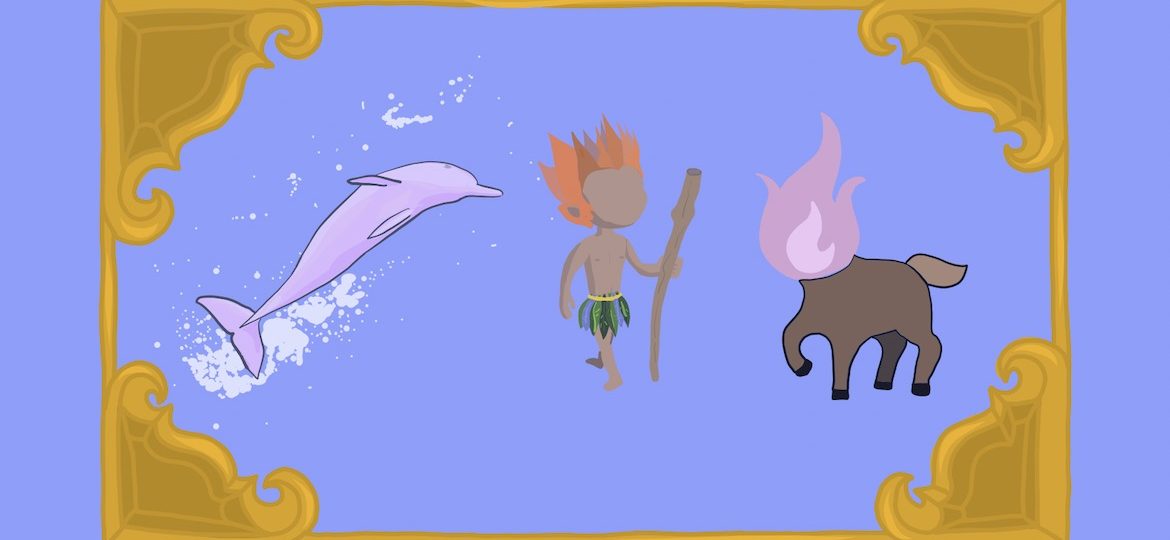Bailam corujas e pirilampos
Entre os sacis e as fadas.
E lá no fundo azul
Na noite da floresta
A lua iluminou
A dança, a roda, a festa…
[O Vira, Secos e Molhados, 1973]
1973. Secos e Molhados, the Brazilian rock fusion band characterized by falsetto and outlandish costumes, releases O Vira. With its repetitive, simple lyrics, O Vira pays homage to magical figures well known by Brazilian children and adults alike.
Magic, in a folkloric sense, is an integral component of the country’s cultural fabric; a direct result of the cliché, but nevertheless true idea of Brazil as a melting pot of many nations and religions. Before my siblings and I were aware of the fact that it was pronounced LeviOsa and not LeviosA or even before we wrapped our heads around the idea that, no, a witches’ tuches does NOT become sore after long distance flights (much to the exasperation of our British relatives who had to first wrap their head around the Yiddish word tuches, never mind why a 7 year old was worried about the practicality of brooms for the comfort of one’s posterior to begin with), we were well versed in Bicho Papão, Mula Sem Cabeça, Curupira and the Boto, to name a few. Some parents chose to conjure the image of the Bogeyman as a consequence of misbehavior. This was very much vanilla in comparison to the creatures we were warned of. Such was the strength of my sister Eliana’s fear of the Lobisomem, that she took to clenching a head of garlic in her sticky toddler fist, after the lady in the restaurant hearing of her terror, told her that it was an effective tool to ward off a werewolf…

Having come across the old tome of lendas (tales), amidst a lockdown induced decision to reorder the bookcases, I began reading the stories that had featured so heavily in my childhood. It will come as no surprise that re-reading folklore at the age of 21 will prompt a series of revelations, at times uncomfortable or positive, as new interpretations present themselves as a natural consequence of a developed awareness of the world, sorely lacking at the age of 7.
Take the tale of the Boto, a pink dolphin that resides in the Amazon considered sacred by those who live there. Legend has it that at night the Boto magically transforms into a young, handsome man dressed in white, who frequents parties in the local tribal villages in search of the most beautiful women. Although for a naïve 7 year old this is nothing but a romantic tale of love, in its re-reading it becomes a clearly problematic story of a predatory man with a penchant for the colour white. A man who disguises himself with the intent to seduce women, only to impregnate them and disappear without a trace. Further research confirmed the sinister implications, revealing that the Boto is often used to explain unexpected or unwanted pregnancies. Its inference of the mystification of sexual assault is transparent, another example of the unforgivable situation of sexual assault in Brazil, which recorded more than 66,000 cases in 2018, over half of the victims under 13 years old. Although the tale is centuries old, its relevance today is a depressing reminder of the inequalities still faced by women in Brazilian society. A fact that has only been exacerbated by a chauvinistic president, whose attitudes regarding women range from not believing in the right for equal pay to taunts about rape directed at his opposition. These attitudes regarding sexual harassment in Brazil can be considered a product of both cultural attitudes and the inadequate laws in place to combat it. Creating a hostile environment in which violence against women is either excused or accepted with the knowledge that a majority of cases are not brought to trial. The tale of the Boto, is hereby a testament of these longstanding ingrained attitudes.
The relevance of mythology in current Brazilian society is not only confined to the legend of the Boto, but rather is evident in most stories, which often demonstrate vital themes regarding environmental issues and solutions. Indeed, the story of Curupira, a short humanoid figure (Curupira meaning ‘child’s body’ in Tupi-Guarani) with fiery red hair, backwards feet and green skin, is a key example of this trend. The legend of Curupira is one of the oldest examples of magical figures in Brazilian folklore and was recounted years before it was first recorded by colonizers in 1560. Curupira has long been hailed protector of the forests, the original eco warrior of sorts, who uses both his cunning and magical abilities to fight the destruction of the rainforest perpetrated by man. In re-reading the tale in today’s climate, this legend transformed from being a slightly scary story of a little demon protector of the forests, to a sobering reminder of the importance of the Amazon and the abuse that it has suffered for centuries. The legend of Curupira shows a deep understanding of the importance of balance and the need to protect what has been dubbed as the earth’s lungs. An understanding that took too long to be comprehended and that even now, despite the severity of the situation, is ignored. The need for Curupira is particularly clear today in light of a 55% increase in deforestation since the start of 2020, a shocking reality that has consequently prompted the deployment of troops to the area. A deployment that can be seen as both an attempt to reduce illegal logging and a shameless effort by the authorities to avoid the label of villain as a result of international criticism. Marcio Astrini, executive secretary of Observatório do Clima, described the deployment as being similar to medicating a disease rather than curing it, a disease created by the government, a disease that he calls Bolsanaro. The tale of Curupira and the environmental villains that he opposes, could thus suggest a certain premonition, a foreboding felt by Brazil’s indigenous ancestors that the day will come when a Curupira-like figure will be needed.
In hearing these legends as children, living outside of the old country, it was aimed to impress on us the importance and richness of our culture. Something that would allow for common ground with our family and equip us with a shared mentality. Emphasis was placed on the legends as legends, disregarding the subliminal messages and current world implications. Whilst possessing this foundation, the re-reading has provided a secondary interpretation that has enriched this understanding, demonstrating the possibility to combine the two in order to teach future generations of socio-environmental issues, through a cultural common ground. It goes without saying that the responsibility to combat these issues is that of the global community and relies on each one of us to stand up against these injustices. However, a very small part of me wishes that Curupira is out there fighting environmental destruction and while we are at it, that Cuca (a humanoid crocodile witch) could perhaps help us out with regards to the homophobic, misogynistic, racist etc.… president currently in office in Brasilia. Just a suggestion!




